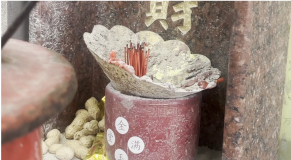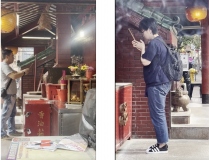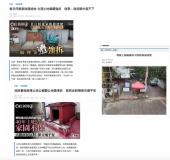Demolition City: Tudi Gong HO Tsz Hei 3036193059
Video link:https://youtu.be/-LaDcIjKZkY
Background
It is not difficult for us to locate red cabinets on the street’s ground level in our daily lives. These are called “Tudi Gong Spirit tablets” (土地公神位), which translates to “Earth god” in English. Since there were numerous Tudi Gong Spirit tablets outside of the shops during my fieldwork, I decided to use Tudi Gong as a theme to look into both the tangible and intangible effects of Tudi Gong’s demolition. Tangible: the present condition of the Tudi Gong spirit object and site, such as temples and tablets. Intangible: Determine the regularity with which these locations are used, as this will give you insight into the customs of modern Hong Kong. The two places I filmed are the street in the previous fieldwork project, the Man Wah building, and the other place is Fuk Tak temple located in Hung Ham.
I also included the Tudi Gong temple in the video because I wanted to delve deeper into the various forms of worship that people were engaging in with Tudi Gong spirit objects.
Literature of Tudi Gong
In order to stay wealthy or in good health, many devotees pray to Tudi. These spirit tablets used to be an essential component of Hong Kong’s customary ritual activities. The days for worshiping the Tudi Gong are the first (初一) and fifteenth (十五) or the second (初二) and sixteenth (十六) of the month. Filming was on May 9th, which is the first (初一) day of the month.
Shop or factory shrines are typically made of wood and painted a bright red color, and they stand or hang on walls at shoulder height, according to Stevens (1980). Plaques or prints of Tu Di Gong, the Earth God, and Guan Di, the patron goddess of merchants, can be found on most shop shrines. From this statement, we know that nowadays Tudi Gong embedded in the external wall on foot level is not the conventional design of Tudi Gong Spirit tablets.
General oblations to the God of the Earth include mochi, which symbolizes sticky money; pastries, such as hair cakes, rice cakes, and small pastries, which symbolize ‘high performance’(高升); peanuts with shells, which represent ‘peeling off the shells and opening up good fortune’(剝殼開運); bananas, plums, pears, jujubes, and pineapples, which have the meaning of ‘inviting you to come to this place of prosperity’(招你來這旺).
Demolition
As the Tudi Gong has the function of blessing the land and the pedestrians, most of the Tudi Gong Temples were built near the main pavements when they were constructed. Most of the Tudi Gong Temples were built in the old days (some of them were constructed in the Sung Dynasty), and the land planning at that time was not yet matured, so there was no regulation on the construction of the Tudi Gong Temples. Nowadays, due to the improvement of land planning, some of the land temples have been demolished due to the obstruction of main pedestrian walkways and their cultural value is not as high as before (as the residents used to believe that the Tudi Gong blessed them with safety, but nowadays, the safety of the temple has been enhanced with the maturity of technology).
Methodology

The Tudi Gong Spiritual tablet is located outside the Cha Chan Teng, and this scene was filmed at the intersection of Man Ying Street and Man Shing Street.
I filmed using a technique called “far to near,” which highlights how we frequently miss these deities because they are out of our line of sight when we go about our daily lives. When they are far away, we hardly notice them.
Scene 2 (00:17 – 00:25)

This is a zoom-out shot of another Tudi Gong Spiritual tablet on the opposite street. I want to capture kinds of oblations, including incense, peanuts, fruit, and candy, to understand the way of worshiping Tudi Gong.
Scene 3(00:26 – 00:34)

The worm view was used to capture this time-lapse image. The community’s relationships and social dynamics with regard to spiritual objects are shown through the time-lapse. Observe how people behave as they pass by the tablets to find any patterns or current trends in how people feel about these holy objects. Nobody paid attention to the Tudi Gong spirit tablets, which was my intentional attempt to attract attention through filming them.
Scene 4(00:35 – 00:38)

I applied mask transition on the place transition to the Fuk Dak temple to create visual continuity in the storytelling of Tudi Gong. The overlapped object (Tudi Gong Spiritual tablet) makes connection on both site, while the scale of Tudi Gong worshiping is larger in Fuk Tak Temple.
Scene 5(00:39 – 00:47)

The scene was captured from the street across from the temple using a second time-lapse technique. We can see that almost no one is approaching the temple for a considerable amount of time using the time-lapse method. Not many people worship the Tudi gong, despite the fact that it is the first (初一) day of the month.
Scene 6 (00:48 – 01:02)

This scene shows from both sides of the Fuk Tak temple. It recorded two worshipers from different perspectives, with different worship motions.
Scene 7(01:03- 02:21)

This scene was filmed in real-time from a first-person perspective, which invites viewers to experience the progress of worshiping the Tudi gong.
Scene 8(02:21- 02:26)

The government accuses the Tudi Gong Temples of illegally occupying government land, which is why I showed three recent news stories about their demolition. With these three stories, I hope to bring viewers’ attention to the destruction of the Tudi Gong temples.
(952 words)
Referencing:
1.Stevens, K. G. (1980). CHINESE MONASTERIES, TEMPLES, SHRINES AND ALTARS IN HONG KONG AND MACAU. jstor.org. https://www.jstor.org/stable/23889544
2.Cheung, C. (2023, June 26). Chinese mythology 101: Tudigong, the god of the land. Localiiz. https://www.localiiz.com/post/chinese-mythology-101-tudigong
3.Fuk Tak Temple. 躍變.龍城–九龍城主題步行徑. (n.d.). https://kowlooncitywalkingtrail.hk/en/story/details/fuk-tak-temple/
4.Au, L. S. (2021, April 17). 昔日何東家族發迹地 樹下土地廟膜拜逾半世紀 一個理由遭強拆. 香港01. https://www.hk01.com/18%E5%8D%80%E6%96%B0%E8%81%9E/613263/%E6%98%94%E6%97%A5%E4%BD%95%E6%9D%B1%E5%AE%B6%E6%97%8F%E7%99%BC%E8%BF%B9%E5%9C%B0-%E5%8F%A4%E6%B4%9E%E5%9C%9F%E5%9C%B0%E5%BB%9F%E9%81%AD%E5%BC%B7%E6%8B%86-%E4%BF%A1%E7%9C%BE-%E6%94%BF%E5%BA%9C%E7%9C%BC%E4%B8%AD%E5%AE%B9%E4%B8%8D%E4%B8%8B
5.Wong, M. H. (2020, November 4). 違法霸公地? 40年「土地公公」家園不保 大批市民反對:保交通平安. 香港01. https://www.hk01.com/18%E5%8D%80%E6%96%B0%E8%81%9E/541342/%E5%9C%B0%E6%94%BF%E7%BD%B2%E6%8C%87%E6%9F%B4%E7%81%A3%E5%9C%9F%E5%9C%B0%E5%85%AC%E5%BB%9F%E9%9C%B8%E5%85%AC%E5%9C%B0%E9%9C%80%E6%B8%85%E6%8B%86-%E5%B1%85%E6%B0%91%E5%8F%8D%E5%B0%8D%E7%A8%B1%E4%BF%9D%E4%BA%A4%E9%80%9A%E5%B9%B3%E5%AE%89
6.Chu, K. M. (2021, April 18). 煙寮土地廟被拆 村民盼原地重置-香港商報. https://www.hkcd.com/content/2021-04/18/content_1262716.html
7.Wan, Y. Y. (2015, February 2). 今日信報 – 副刊文化 – 保佑學業土地公 – 溫婉玉 – 神廟尋秘. 信報網站 hkej.com. https://www1.hkej.com/dailynews/culture/article/982279/%E4%BF%9D%E4%BD%91%E5%AD%B8%E6%A5%AD%E5%9C%9F%E5%9C%B0%E5%85%AC
8.Mathas, J. R. G. (1980). “A study of the jiao, a Taoist ritual, in Kam Tin, in Kam Tin, in the Hong Kong New Territories.” https://ora.ox.ac.uk/objects/uuid:d792b22b-0ab9-4dc7-b7d5-08c12ffcbbe6/files/m9b528bf98d3c0ae8423d33c3fd3d0cf4
Additional reference:
10.https://www.facebook.com/100064629254322/posts/2300085633611341/
Hi HO Tsz Hei Tea, I like your theme “Tudi Gong” very much. This is a theme that did not receives too much attention. So, this is a good choice for you to choose this topic. In today’s rapid urban development, we must insist on preserving this traditional Chinese culture.
I really appreciate that you used first-person vision to shoot the “worshiping God” part. This allows us readers to feel like we are the protagonist even though we are separated from the screen. It is very interesting. Moreover, I think it is wise for you to choose this shooting method, because for most of our students at the University of Hong Kong, there are many foreigners/non-locals, and they may not know much about these traditional Chinese cultures. Therefore, your choice of subject matter and shooting method It can deepen foreigners’ understanding of Chinese traditional culture.
In terms of suggestions, first, I think your time-lapse photography technique is very good in terms of matching the subject, but when shooting, I suggest you use a mobile phone stand so that your video will be more stable. Second, in the second half of the video, which is the first-person shooting part, I suggest that you shoot with the camera horizontally rather than vertically. In this case, your entire video will be more coherent.
Anyway, Well Done !!!
Yan Chi Hong
UID: 3035565619